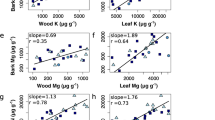Abstract
Recent field experiments with impregnated wooden sticks have demonstrated a pronounced use by small rodents of mineral supplies, especially sodium, and such findings seemed related to vole damage to forestry seedlings. Consumption of the bark of experimentally introduced aspen twigs and of sodium-impregnated sticks by voles (mainly or onlyMicrotus agrestis) correlated significantly on clear-cuts but not on unmanipulated abandoned fields. Such a correlation appeared when abandoned fields were cut continuously in summer. At vole peak densities, bark of pine seedlings experimentally fertilized with sodium was consumed but not bark of seedlings fertilized with calcium or control seedlings. Field pine seedlings attacked by voles had significantly higher levels of calcium, sodium, and phosphorus than the nearest untouched seedling. However, sodium and phosphorus contents correlated strongly. Sodium and calcium supply to voles in laboratory feeding trials did not diminish the moderate interest in pine bark. Such conditions are, however, assumed to mimic a situation of bark sampling in low-density populations. Sodium, and possibly also calcium, requirements are concluded to be partial determinants of the destructive bark consumption by voles at the peaks of their multiannual population cycles.
Similar content being viewed by others
References
Barkley, S., Batzli, G.O., andCollier, B. 1980. Nutritional ecology of microtine rodents: a simulation model of mineral nutrition for brown lemming.Oikos 34:103–114.
Batzli, G.O. 1986. Nutritional ecology of the California vole: Effects of food quality on reproduction.Ecology 67:406–412.
Hansson, L. 1971. Habitat, food and population dynamics of the field voleMicrotus agrestis (L.) in south Sweden.Viltrevy (Swedish Wildlife) 8:267–378.
Hansson, L. 1979. Food as a limiting factor for small rodent numbers: Tests of two hypotheses.Oecologia (Berlin) 37:297–314.
Hansson, L. 1985. The food of bank voles, wood mice and yellow-necked mice.Symp. Zool. Soc., London 55:141–168.
Hansson, L. 1988. Grazing impact by small rodents in a steep cyclicity gradient.Oikos 51:31–42.
Hansson, L. 1989. Landscape and habitat dependence in cyclic and semi-cyclic small rodents.Holarct. Ecol. 12:345–350.
Hansson, L. 1990. Mineral selection in microtine populations.Oikos 59:213–224.
Hansson, L., andHenttonen, H. 1985. Gradients in density variations of small rodents: the importance of latitude and snow cover.Oecologia (Berlin) 67:394–402.
Hansson, L., andJaarola, M. 1989. Body size related to cyclicity in microtines: Dominance behaviour or digestive efficiency?Oikos 55:356–364.
Hansson, L., andLarsson, T.-B. 1978. Vole diet on experimentally managed reforestation areas in northern Sweden.Holarct. Ecol. 1:16–26.
Inouye, R.S., Huntley, N.J., andTilman, D. 1987. Response ofMicrotus pennsylvanicus to vegetation fertilized with various nutrients, with particular emphasis on sodium and nitrogen concentrations in plant tissues.Holarct. Ecol. 10:110–113.
Larsson, T.-B. 1973. Smågnagarskador på skogskulturer i Sverige 1900–1970.Rapp. Uppsatser, Inst. Skogszool. 14. 26 pp.
Lichens, G.E., andBorman, E.H. 1970. Chemical analyses of plant tissues from the Hubbard Brook ecosystem in New Hampshire. Yale University School of Forestry, Bulletin No. 79. 25 pp.
MyllymÄki, A. 1977. Outbreaks and damage by the field vole,Microtus agrestis (L.), since World War II in Europe.EPPO Bull. 7:177–208.
Pehrson, å. 1983. Digestibility and retention of food components in caged mountain haresLepus timidus during the winter.Holarct. Ecol. 6:395–403.
Stenseth, N.C., Hansson, L., andMyllymÄki, A. 1977. Food selection of the field voleMicrotus agrestis.Oikos 29:511–524.
Weeks, H.P., andKirkpatrick, C.M. 1978. Salt preferences and sodium drive phenology in fox squirrels and woodchucks.J. Mammal. 59:531–542.
Author information
Authors and Affiliations
Rights and permissions
About this article
Cite this article
Hansson, L. Bark consumption by voles in relation to mineral contents. J Chem Ecol 17, 735–743 (1991). https://doi.org/10.1007/BF00994196
Received:
Accepted:
Issue Date:
DOI: https://doi.org/10.1007/BF00994196




